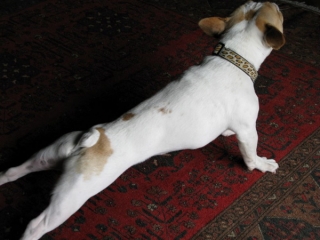Interpretive Dance

Lots of debate out there about how best to train dogs. Of course there is no one way to train all dogs, or even one way to train one dog. There is no magic formula that will work every time, like clockwork. Dogs are living, breathing, thinking creatures and we form relationships with them, which adds to the dynamic as well. Even the long and well-practiced methods of a seasoned trainer will need adjustments for each individual trainee in each individual context. This is the art of dog training in my opinion and while some people may instinctively be better at it than others, years of practice will help those less naturally inclined, because dog training is also a skill.
So a toolbox should be chock-full of tools (metaphorically in my opinion – the less physical tools used in the beginning the less you’ve got to fade later) but even so, each person should choose their tool-set carefully and do their best to master the technique before adding another being into the mix.
I take tango lessons and the instructor always has us try new moves alone before adding a partner. First get the footwork down, then try it with an experienced dancer to practice a bit and work on technique (this also allows the student to feel what it should feel like to dance, probably helps the muscle memory), then try the moves with another novice. We never start novice-to-novice; it would be immensely frustrating and somewhat dangerous. (Don’t think dancing can be dangerous? Ha! Try it. Bruises and broken toes abound, not to mention a sprained ego here and there and a few popped blood vessels from embarrassment.) Makes you think about the set-up of the average dog training class, doesn’t it?
One of the tools I like to use is free-shaping. This technique allows dogs to make choices and use their creativity to problem solve, kind of like a game of hot and cold. I don’t use it all the time, or even for most basic behaviors (because I find it takes too long) and I rarely use a clicker – that’s just my preference – but is can be an extremely rewarding way to work for both dog and human. Fun stuff comes out of releasing expectation and going with the flow.
Recently I was working with Hugo, my little French Bulldog, doing some shaping. I had a loose goal in mind, working on rollover, but I was relaxed and open to where the process led us that day. (No imminent rollover competitions on the horizon to put the pressure on, we were just training for mental stimulation.)
Well, Hugo is an extremely enthusiastic worker and fancies himself quite the athlete in spite of his disproportionately large head, stubby legs, and somewhat swine-like body shape. He never lets form stop him from function. Take that Darwin! (Disclaimer – I love Darwin, this is Hugo talking and he refuses to believe that a Frenchie body thwarts his plan to take over the world.)
So we are working on rollover in my mind, and I had lured him a bit for it in the past, so it wasn’t completely new to him. As we worked he happily tried different things and got rewarded for getting warmer – towards his roll. Suddenly Hugo’s inner Mark Morris took over and instead of simply rolling over, which should be pretty easy for him considering his shape, he choreographed this very specific and complex modern dance move, almost like break dancing, but with a little more flourish. I rewarded him with laughter, praise, and a bit of cheese because it was so darn cute and creative. And, true to the technique, he did it again. And again. And again. Hugo was dancing! His roly-poly body twisted and lurched into a mass of grace and motion! (Okay, I am stretching it a bit to call it grace, but I am just sure he felt graceful and free. That is what it looked like anyway, pure joy!) A move he had made up entirely by himself (yes, by chance, I know) and the funniest thing about it was that he did it almost exactly the same way every time. Heck, why can’t I get that sort of reliability with a straight sit or a contact nose touch?
I didn’t throw my plans out the window entirely. I still wanted to teach him to rollover reliably and actually I already have done so. However, had I been stuck on one narrow outcome for our training session that day I’d have missed the chance to see this wonderful performance and put it on cue. Our repertoire has expanded and we had an excellent time and that is what it’s all about really, isn’t it?




